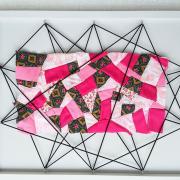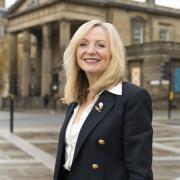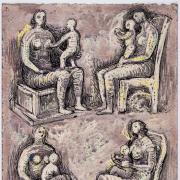Iain Logie Baird, curator of television at the National Media Museum in Bradford and Grandson of the inventor of television talks to Jo Haywood.
Thinking outside the box
In most family photographs grandfathers are pictured dandling a small child on their knee. But in the Baird album he’s cradling a cathode ray tube.Perhaps it’s not surprising then that Canadian-born Iain Baird had a strong inkling from a very young age that his Scottish ancestor was not your everyday, run-of-the-mill grandparent.‘It was a gradual process of realisation,’ he said. ‘My dad would occasionally go off to give talks about his father. Kids would come up to me at school and say “hey, your grandfather invented television”. I would occasionally see a documentary on television about him. And when I read an encyclopaedia, he would have his own section.‘He was fairly well known in Canada, but nothing like he is here. Back home it was more about what he did than the man himself. The significance of television and his role in it was something I became increasingly aware of over time.’On October 2nd 1925, John Logie Baird was the first person to successfully transmit a television picture of a ventriloquist’s dummy nicknamed Stooky Bill. It was a 30-line vertically scanned greyscale image, and it changed everything. Not least for Baird himself.‘He was almost afraid of what to do next,’ said Iain, one of the television pioneer’s five grandchildren. ‘He knew he was the only person at that time to successfully generate a television image, and he was very aware of its potential. ‘He was afraid that one of the big radio companies would come in and make a move. So he set up his own company, Television Limited, and for about 14 months was the only one to be able to get the technology to work.’Baird filmed a dummy because it wouldn’t complain about the heat from the lights, which could reach about 40 degrees C. This didn’t protect the inventor from the heat, but he was used to being uncomfortable in his lab. ‘He would regularly get electric shocks,’ said Iain, ‘and the scanning wheel would occasionally fly apart, showering him with broken glass.’Baird also had to learn to roll with the punches dealt out by big business. Within two years, his competitors started to move ahead of him and he became estranged from his own company. This led to many commentators labelling him as a great inventor but a poor businessman.‘He was very commercial-minded,’ said Iain. ‘He was an inventor but he was also an entrepreneur. He had successful businesses before. He created super-warm socks – hardly a high-tech business, but a successful one. People couldn’t wait to try them.‘He also brought out a cleaning soap. Although there are always some people who just don’t get it. One woman came to him with her child who had terrible diaper rash. She was yelling “look at what your soap did to my child”. He then had to explain to her that the soap was for cleaning floors.’But it wasn’t just his soap that baffled people. A great many just couldn’t see the point of television.‘They couldn’t see that television would ever be as important as radio,’ Iain explained. ‘And if they wanted a visual experience they could just go to the movies. ‘But my grandfather was more of a visionary. He could see that this was a new means of communication to rival both radio and film. He knew that it wasn’t just going to cut the market share, it was going to create a whole new market.’It becomes clear in even a relatively short conversation with Iain Baird that he is passionate about his grandfather’s work. It seems inconceivable now that he would ever have been anything other than curator of television at a world-renowned museum, but he took a rather winding path to reach his destination.He studied urban planning at university and assumed he would become an architect or planner after graduation. But he became disillusioned with modern architecture, finding more of interest in the past rather than the future of this profession.He eventually made a living as an antique dealer and restorer, making good use of the hands-on, Mr Fix-It gene he inherited from his grandfather. But still he knew this wasn’t the career for him. ‘I was always the techie guy,’ said Iain. ‘The one who was interested in the tubes and wires. Then I got interested in the content – the stuff that fills the empty box.’He readily admits that Canadian television was pretty terrible, mainly because it was made up of around 80 per cent American imports. But he did get to see some British programmes, including Brideshead Revisited, Tenko and – his favourite – Sleepers (a comedy drama starring Nigel Havers and Warren Clarke).‘I don’t think you learn about television by watching it though,’ he said. ‘You learn from reading about it. You have to remove yourself from the system to learn about it.’Iain began his curatorial career at Toronto’s privately-owned MZTV Museum, which later transferred its collections to Cinematheque Quebecoise in Montreal and the Royal Ontario Museum in Toronto. Before making his big move to Bradford three years ago, he was assistant curator at Toronto’s Canadian Broadcasting Centre Museum.‘I came here for the job, but now I feel right at home in Bradford,’ he said. ‘It’s got a great history and really interesting architecture. Walking round the city now it feels like it’s on the road to recovery and that things are getting more positive as time goes on. And we do our bit at the museum by being a beacon for gentrification to help improve the local economy. ‘This is the home of Hockney, Priestley and Delius, and it’s also the first City of Film in the world. These are all good reasons to celebrate. Every city has its identity and Bradford’s is definitely still in flux. But that’s what makes this such an exciting time.’The museum is currently hosting two major exhibitions, one on soaps (thankfully Hollyoaks never made it to Canada so Iain has had little input here) and another called Mirrors In The Sky, charting the satellite revolution and how it reflected changes in British culture.‘Part of my job here is to get the balance right between entertainment and learning,’ said Iain. ‘People generally come here for a fun day out, they’re not looking for a day at the Open University, but that doesn’t mean they don’t want to be challenged. ‘I don’t like to be didactic. I like to leave gaps and take a more mosaic approach. You have to give people something they already know, that resonates with them, before introducing them to something new.’So what is going to be the next big new thing in televisual terms? ‘I think 3D is having its time,’ he said. ‘It’s already changing the watching experience. In terms of home-viewing, 3D is going to be for the home theatre people – you know, the sort of people who got very excited when satellite TV came out and were constantly asking how many channels you had and snorting in derision if you only had four.’But would his grandfather John Logie Baird be surprised at what his invention has become?‘Less surprised than you might think,’ said Iain. ‘He developed stereoscopic images in 1927 which, in effect, was 3D television. Sometimes new technology is really not that new at all.’
For more information about the National Media Museum in Bradford, which has seven floors of interactive galleries, a rolling programme of special exhibitions and three cinemas including an IMAX, phone 0870 701 0200 or visit www.nationalmediamuseum.org.uk.


























